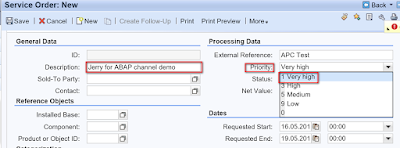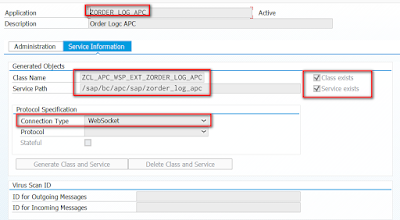In that blog some demo examples are explained. After going through those impressive tutorials and demos, have you ever thought about building some useful stuff for your daily work by leverage this powerful feature in ABAP?
As ABAPers we use various trace / monitor tools in our daily work, such as SAT and ST05. And in CRM, all business transactions are managed by so called One Order framework. This framework uses function module CRM_ORDER_MAINTAIN to create, update and delete the document.
Just look at this long list of importing parameters
As ABAPers we use various trace / monitor tools in our daily work, such as SAT and ST05. And in CRM, all business transactions are managed by so called One Order framework. This framework uses function module CRM_ORDER_MAINTAIN to create, update and delete the document.
Just look at this long list of importing parameters
As an CRM application developer I have to frequently check what data has been put into these importing parameters during my development and trouble shooting life. I am so lazy that sometimes for minor issue I am reluctant to open ABAP Debugger.
This trace tool still has some drawback: when I perform the operation under trace mode, it is impossible for me to review the trace result in the real time. In order to see the trace result, I have to terminate the trace and then review the result in SAPGUI.
Is there any more convenient way to see the trace data in real time? Yes, it is time now to practice using ABAP Channel.
I have built another trace tool on my own. Let’s first see what feature it can support:
1. Open the trace monitor in browser, which is a BSP application:
2. Go to your application to be traced and perform the operation as usual.
In my example, I create a new service order, and maintain fields like Description, External Reference, Priority, Pricing Date and Currency.
Switch to my monitor application, all trace data are displayed in the real time.
Since now all trace data are displayed directly in browser, it is much easier for me to search some data I am interested using text search than searching something in SAPGUI.
Here below is the step by step how to build this tool.
1. tcode SAPC, create a new APC application, in my example my APC application name: ZORDER_LOG_APC.
Click button “Generate Class and Service” to generate handler class and ICF node automatically. You can refer to my setting below.
2. tcode SAMC, create an AMC application ZORDERLOG.
Maintain the automatically generate class from step 1 into Authorization Program column.
So far all modelling task are done.
3. Implement class CL_CRM_ORDER_LOGGER, which will be responsible to send the logged data to a web socket.
The complete source code could be found from my github.
In the class_constructor, I get a message producer instance by passing the AMC application id and channel id which are created in step2.
The actual send of message is done by the send method of this instance:
4. Redefine ON_START method of the APC handler:
In this method we just bind this APC application with AMC application we created in step 2.
METHOD if_apc_wsp_extension~on_start.
DATA: lo_request TYPE REF TO if_apc_ws_initial_request.
DATA: lo_binding TYPE REF TO if_apc_ws_binding_manager.
DATA: lx_error TYPE REF TO cx_apc_error.
DATA: lv_message TYPE string.
TRY.
lo_request = i_context->get_initial_request( ).
lo_binding = i_context->get_binding_manager( ).
lo_binding->bind_amc_message_consumer( i_application_id = 'ZORDERLOG'
i_channel_id = '/order_log' ).
CATCH cx_apc_error INTO lx_error.
lv_message = lx_error->get_text( ).
MESSAGE lv_message TYPE 'E'.
ENDTRY.
ENDMETHOD.
For method ON_MESSAGE, we can just keep it as empty.
5. I create an enhancement on function module CRM_ORDER_MAINTAIN to inject my logger API there:
6. In this last step, build an BSP application where a websocket is created to listen to the message sent from ABAP.
Create an BSP application with one page index.htm,
And paste the following HTML source code to it and activate:
<html ng-app="nameApp">
<head>
<meta charset="utf-8">
<title>Jerry's One Order Trace tool using ABAP Channels</title>
<script src="https://i042416.github.io/FioriODataTestTool2014/WebContent/angular/angular.js"></script>
<script>
var nameApp = angular.module('nameApp', []);
nameApp.controller('NameCtrl', function ($scope){
function getCurrentTime(){
return new Date().toLocaleString();
}
(function init(){
$scope.Ionames = ['Jerry\'s One order log tool'];
var startTime = 'Trace Start Time:' + getCurrentTime();
$scope.Ionames.push(startTime);
var that = $scope;
var sUrl = "wss://<host>:44300/sap/bc/apc/sap/zorder_log_apc";
var ws = new WebSocket(sUrl);
var onMessage = function(evt){
this.Ionames.push(getCurrentTime( ) + ':' + evt.data);
this.$apply()
};
ws.onmessage = onMessage.bind($scope);
})();
});
</script>
</head>
<body ng-controller="NameCtrl">
<ul>
<li ng-repeat="nameF in Ionames">{{nameF}}</li>
</ul>
</body>
</html>
You only need to use your own APC application url when creating Web socket instance.














No comments:
Post a Comment